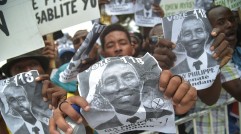New White House Study Finds Hispanics, Blacks Comprise Most of Prison Population, Poor and Vulnerable Often Targeted
Hispanics and blacks comprise over half of the U.S. prison population, even though the two groups make up less than one-third of the overall U.S. population.
Such findings are part of a new White House report titled "Economic Perspectives On Incarceration And Criminal Justice," which also finds the overriding number of Americans have grown weary of "tough on crime" policies that have served to greatly inflate the inmate population.
U.S. Is World's Largest Jailer
With the U.S. now serving as the world's biggest jailer, critics are clamoring for reforms that take into account the "financial and human costs" decades of mass incarceration policies have led to. Though the U.S. now serves as home to just five percent of the world population, the report, nonetheless, found that it houses at least 25 percent of all the world's prisoners. Overall, some 2.2 million people are now serving time in jails and prisons across the U.S., accounting for a starling rise of 220 percent over a 34 year period beginning in 1980.
Researchers noted that rise came about despite a drastic reduction in the overall crime rate and a drop of some 39 percent in the violent crime rate. Data also showed such factors as rising incomes and failing unemployment were largely responsible for the reductions.
When it comes to minorities, researchers found Hispanics and blacks face a far greater likelihood of arrest and conviction than whites when committing the same crimes. In addition, penalties and sentences tended to be much harsher when it came to minority suspects.
Poor, Vulnerable Have Become Easy Targets
Overall, the poor and the vulnerable were found to be much more likely to be among the harshest penalized. For example, one in 10 incarcerated individuals was found to be homeless in the year before incarceration; over 10 percent of the incarcerated grew up in foster care; almost 60 percent of people behind bars are mentally ill and roughly 65 percent of all prisoners never completed high school.
"Criminal justice sanctions can compound existing disadvantages for these populations, reinforcing patterns of intergenerational poverty," the report concluded.
And none of it comes cheaply. The U.S. is estimated to spend at least $80 billion on incarceration annually, and over $270 billion on the entire criminal justice system. Overall, America employs nearly three times the number of correction officers per capita of any other nation, but makes use of nearly 30 percent fewer police officers.
Just three years ago, at least 11 states were found to have spent more on jailing people than on higher education.
As for the human toll all the imprisonment and arrests have rendered, researchers found nearly one-third of all adult Americans, or 70 million people, now some sort of criminal record. The end result is roughly five million minors now have at least one parent that has served time behind bars, with those rates proving to be two to seven times higher for Hispanic and black children.
All that for a system researcher's hint may not even be serving its stated purpose.
"Given the size of the U.S. incarcerated population, the aggregate crime-reducing impact of increasing incarceration rates is likely to be minimal," the report added.
Beyond that, the overwhelming majority of research seems to indicate the more time a person serves behind bars the more likely they are to again engage in criminal activity upon release. Juvenile offenders have also shown a propensity for falling victim to the same trend, thereby decreasing the likelihood of any of them ever earning a high school diploma.
In the end, researchers concluded a far more cost-effective and beneficial criminal justice system is possible, but it would require a far more humane and holistic approach.
Subscribe to Latin Post!
Sign up for our free newsletter for the Latest coverage!














